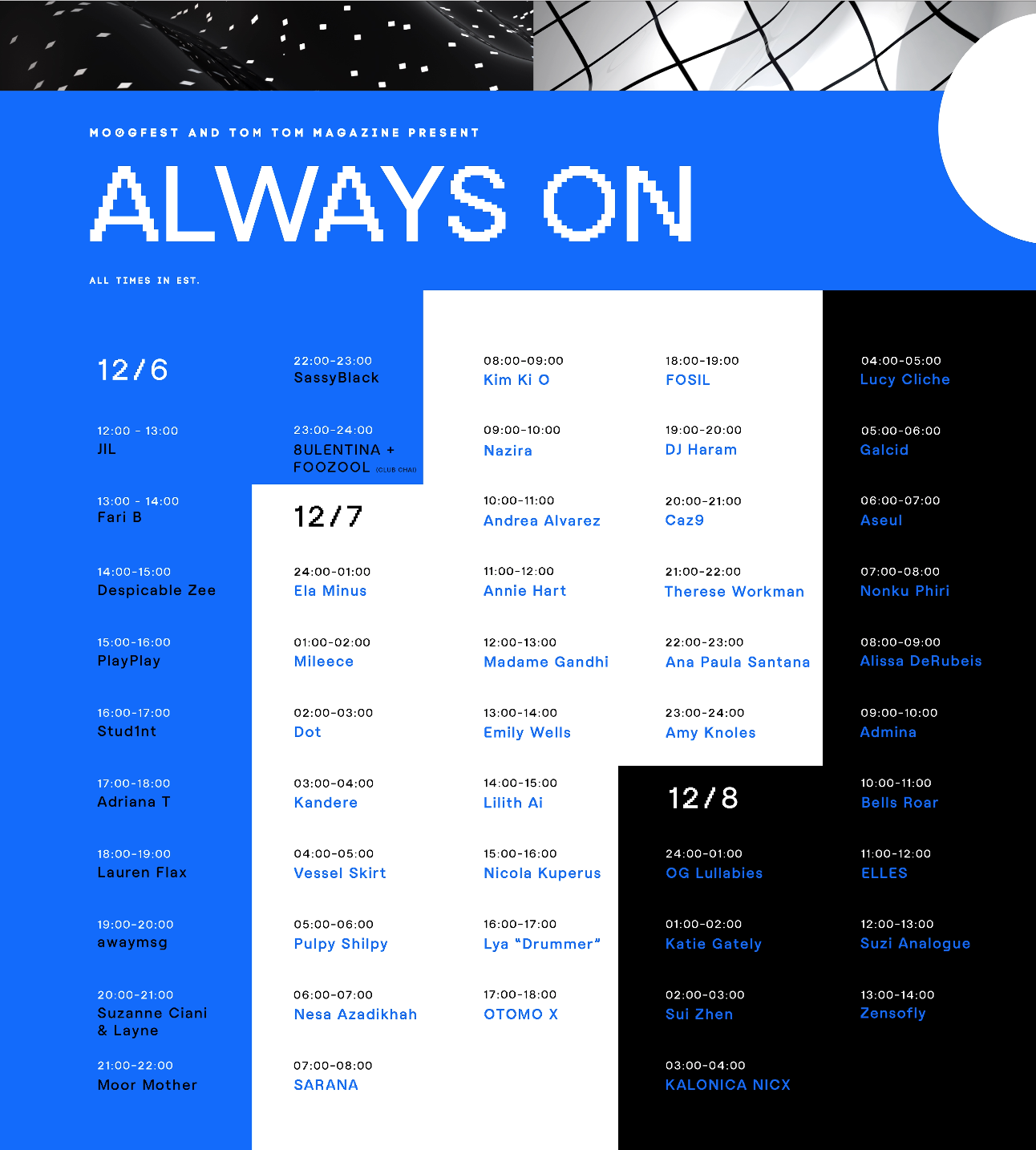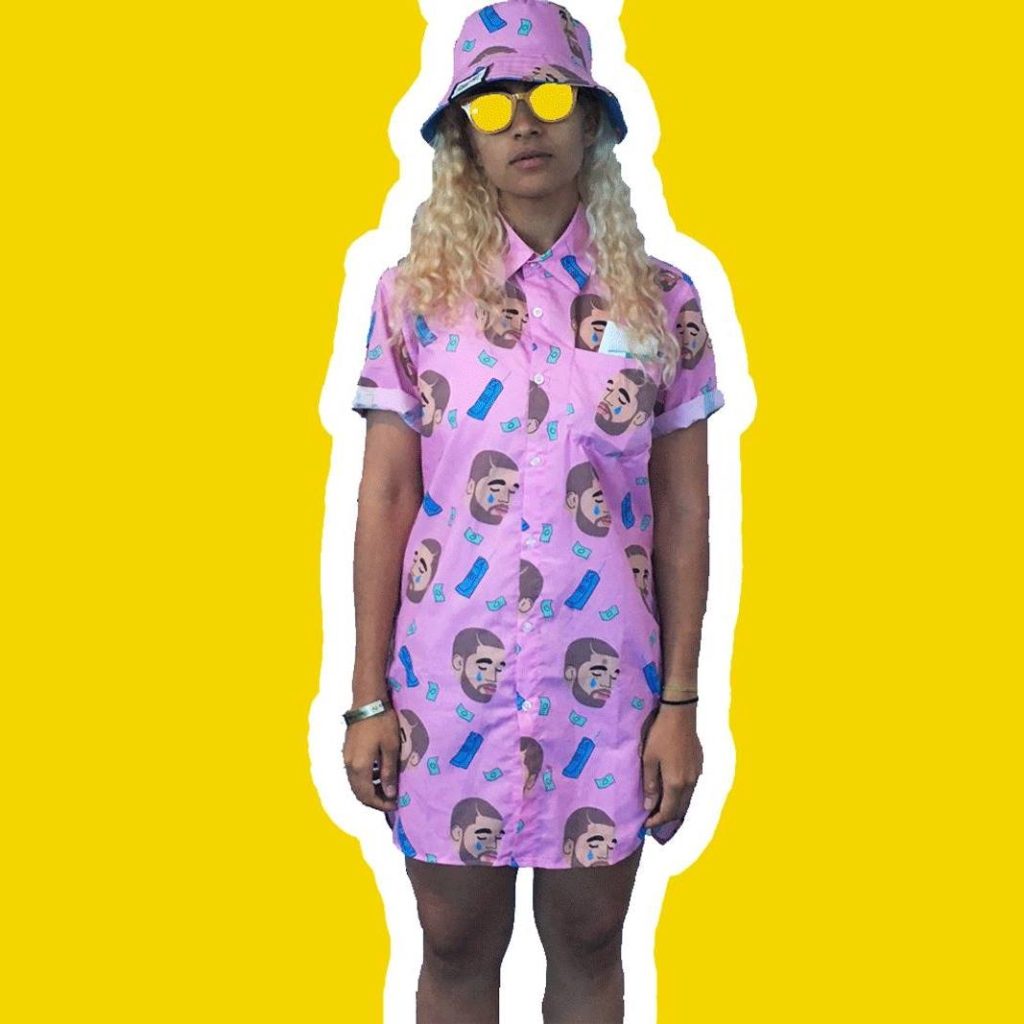By Jasmine Bourgeois
Tom Tom got the chance to chat with some of the artists participating in Always On, a 50-hour livestream with continuous performances from female, transgender, and non-binary artists. We partnered with Moog to present this livestream to highlight the abundance of female, transgender, and non-binary artists creating and performing electronic music and beats around the world. The livestream runs until to 2:00pm ET on December 8, 2017. Check out the artists below and be sure to follow their social media pages!
Madame Gandhi
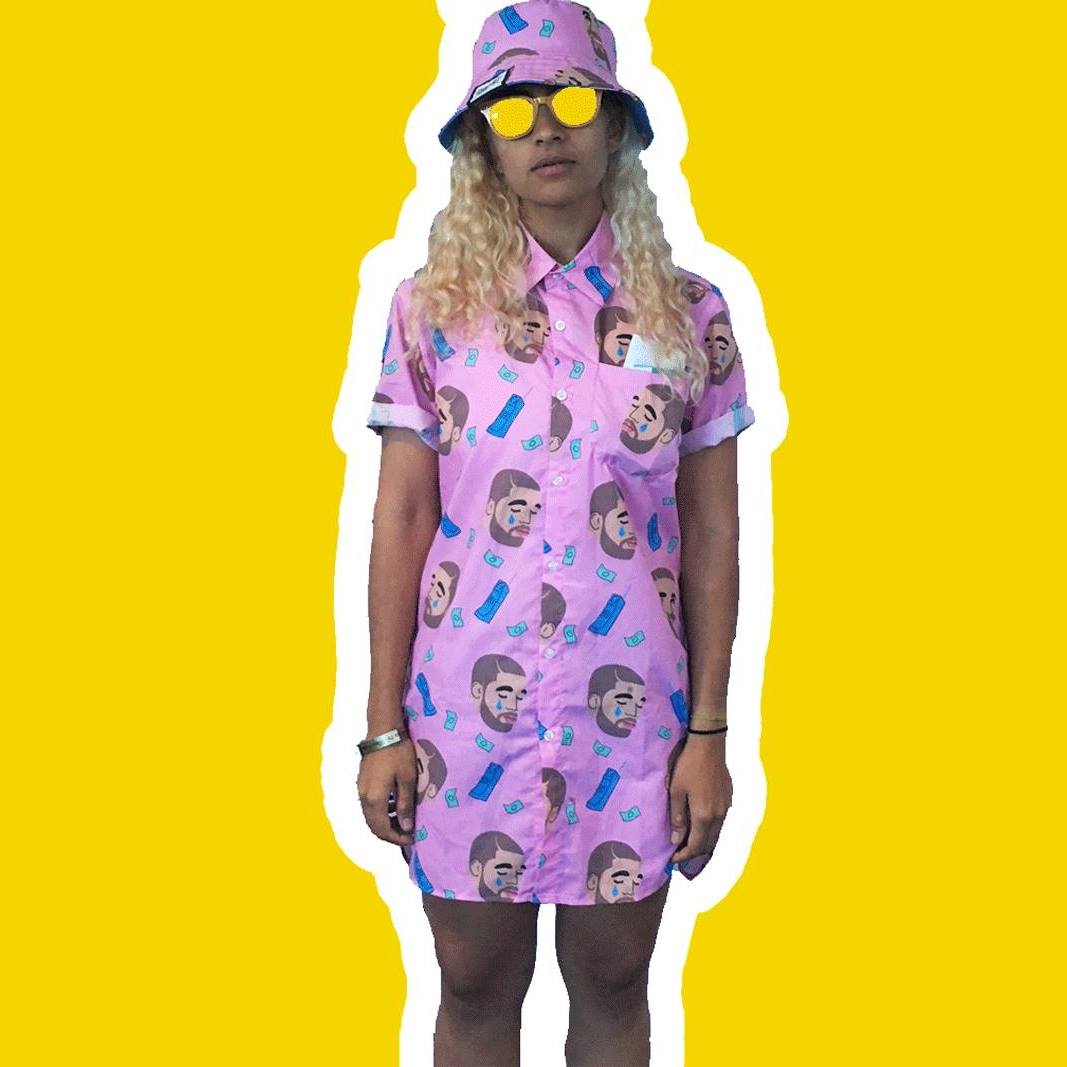
Kiran Gandhi, also known as Madame Gandhi, is a musician and activist. She’s been playing music since she was four, has played at major music festivals, and has gained notoriety for drumming for M.I.A. Since the start of her career, she has been a vocal advocate for women and femme-aligning people in and outside of the music industry. She released her debut EP, “Voices,” in 2016 and it quickly garnered massive recognition for its emphasis on femininity and unapologetic politicism. She’s a total badass outside of the world of music as well — in 2015 she made headlines for free-bleeding while running the London Marathon and helped make space for open dialogue around menstruation stigma. On top of all of this, she’s a graduate of Georgetown University and Harvard Business School, the latter of which she attended while touring the world with M.I.A. Madame Gandhi is a talented artist and fierce advocate whose goal is to make music that makes people feel good, engage in important conversations, and “elevate and celebrate the female voice.”
“I want to get better at making music because it can make people feel good and affect their moods in that way.”
How did you get into music? How did that progress into electronic music?
I always liked music growing up. I was always playing with the radio and always making mix CDs for friends. I loved going to live shows too. I started DJing and playing drums when I was a teen; by the time I was 24 I was playing with M.I.A; it just started growing and growing, and I realized how powerful music is. It has the power to change the world and influence people. That’s kind of how it shifted into electronic music. I loved the fact that I could bring my drums and my voice to music and innovate something. I think with electronics and synths you can make music you’ve never heard before, which is profound. And at a meta-level I think there’s a deep feminism in women being good at [electronic music] and expressing themselves that way. If only men are good at it then those are the only voices we hear. More women making music electronically is a good way of bringing alternative narratives and stories into the picture.
What is the appeal of electronic music for you?
The flexibility, the ability to innovate sound that no one’s heard, and the ability to make beautiful sounds. I have a new song that’s not released yet and I made a new sound by sampling my voice in a certain way that sounds bright… [and] people’s energy shifts when they hear it; they tell me it makes them feel bright and hopeful. And music does have the power to elevate people. I want to get better at making music because it can make people feel good and affect their moods in that way.
For you, personally, what’s it like to be a part of Always On?
I feel really lucky. I’m going to be part of a cohort of producers who have been doing it much longer than I have. I feel really lucky to be included in the lineup and to be considered alongside so many of the greats and to be proving to the world and showing in a transparent way that at any minute you can tune into anywhere in the world and see women and female-identifying people making music that they’re good at. It’s also combatting the myth that there are no female producers.
Even though I’m American and live in LA, it’s cool that I get to do the livestream in India; I think it’s great that people can be dialing into women producers doing their thing all over the world.
Keep Up With Madame Gandhi
Soundcloud/Twitter/Facebook/Instagram
SARANA
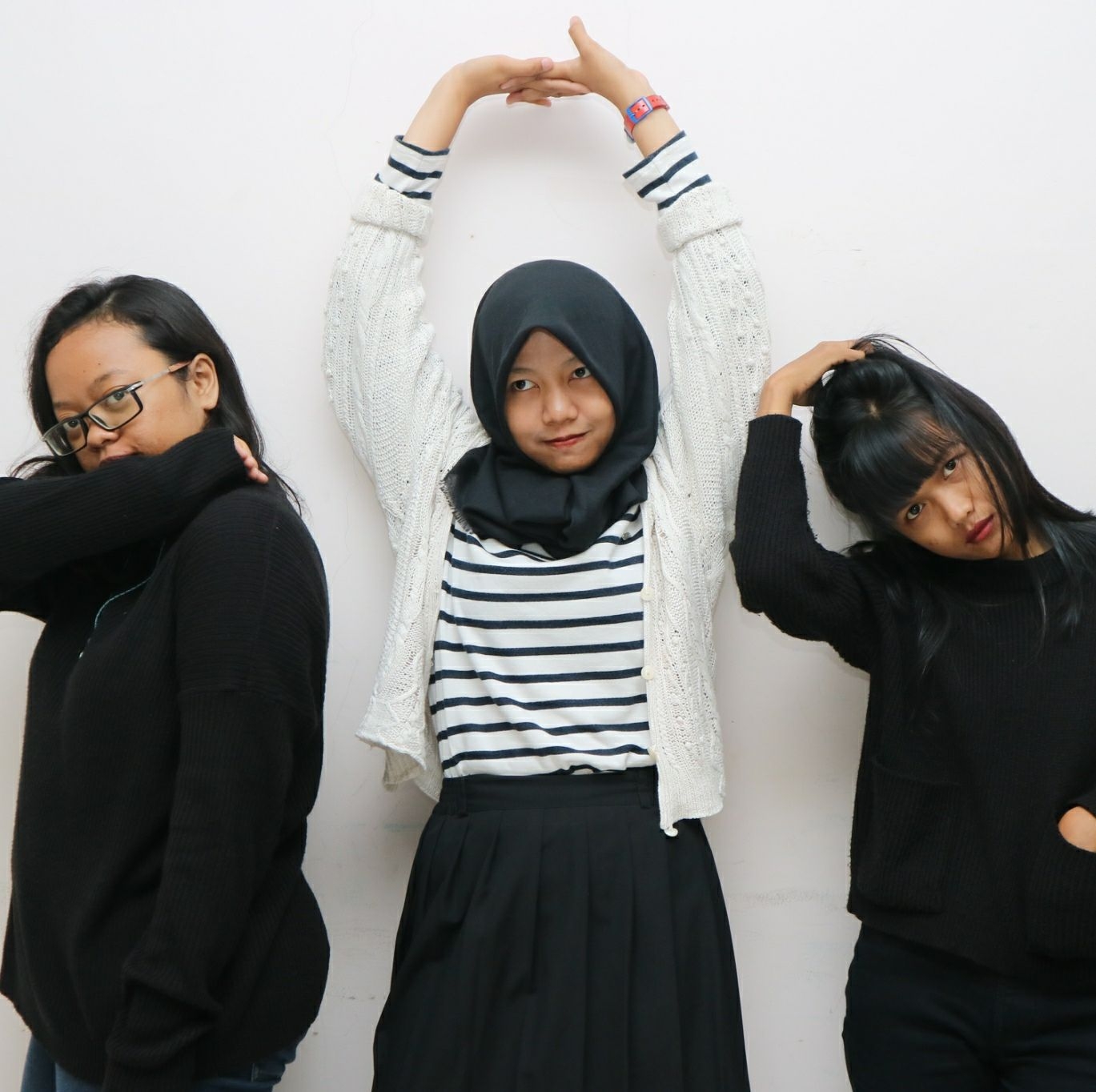
Self-described as a “girl noise collective,” Sarana is a truly experimental group who utilize the full range of sounds and sound-making to create a unique form of music unlike anything you’ve ever heard. Sarana is Annisa, Istanara, and Sabrina who hail from Samarinda, Indonesia. The trio uses a chaotic mix of feedback samples, (mostly) clean speech, distorted riffs, and radio-esque fuzz to create something that falls between noise-art project and revolutionary electronic music. They take bold risks and deliver a totally non-conventional sound that’s reminiscent of the peculiarity and exploracious-ness of early electronic music projects.
“Electronic music for us is about expressing and appreciating ourselves. We can make something based on what we feel at that time. We create our life with it.”
How did you get into music? How did that progress into electronic music?
We met when we held a music fest in Samarinda. After that, we were trying to play noise together. We’ve been playing since May 14th 2015; two years and still counting.
What is the appeal of electronic music for you?
Electronic music for us is about expressing and appreciating ourselves. We can make something based on what we feel at that time. We create our life with it.
Who are some of the artists who have influenced your sound?
We have different influencers. Sabrina likes Xiu-Xiu, Prurient and John Maus. Istanara likes Pharmakon and Pripoy, and Annisa likes Point of Entelechy, Pedestrian Deposit and Palasick.
How would you describe your sound to someone who’s never heard you before?
We always let people have their own thought about our sound. Some people think it’s nice; some people think it’s creepy. We just explain to them that we just experiment with sound around us.
For you, personally, what’s it like to be a part of Always On?
We were shocked when Always On contacted us. We live in small city and this project invited us to participate in it. It’s just like a dream for us. [We] hope we can give our best for Always On.
Keep Up With SARANA
Soundcloud/Twitter/Facebook
Fari B
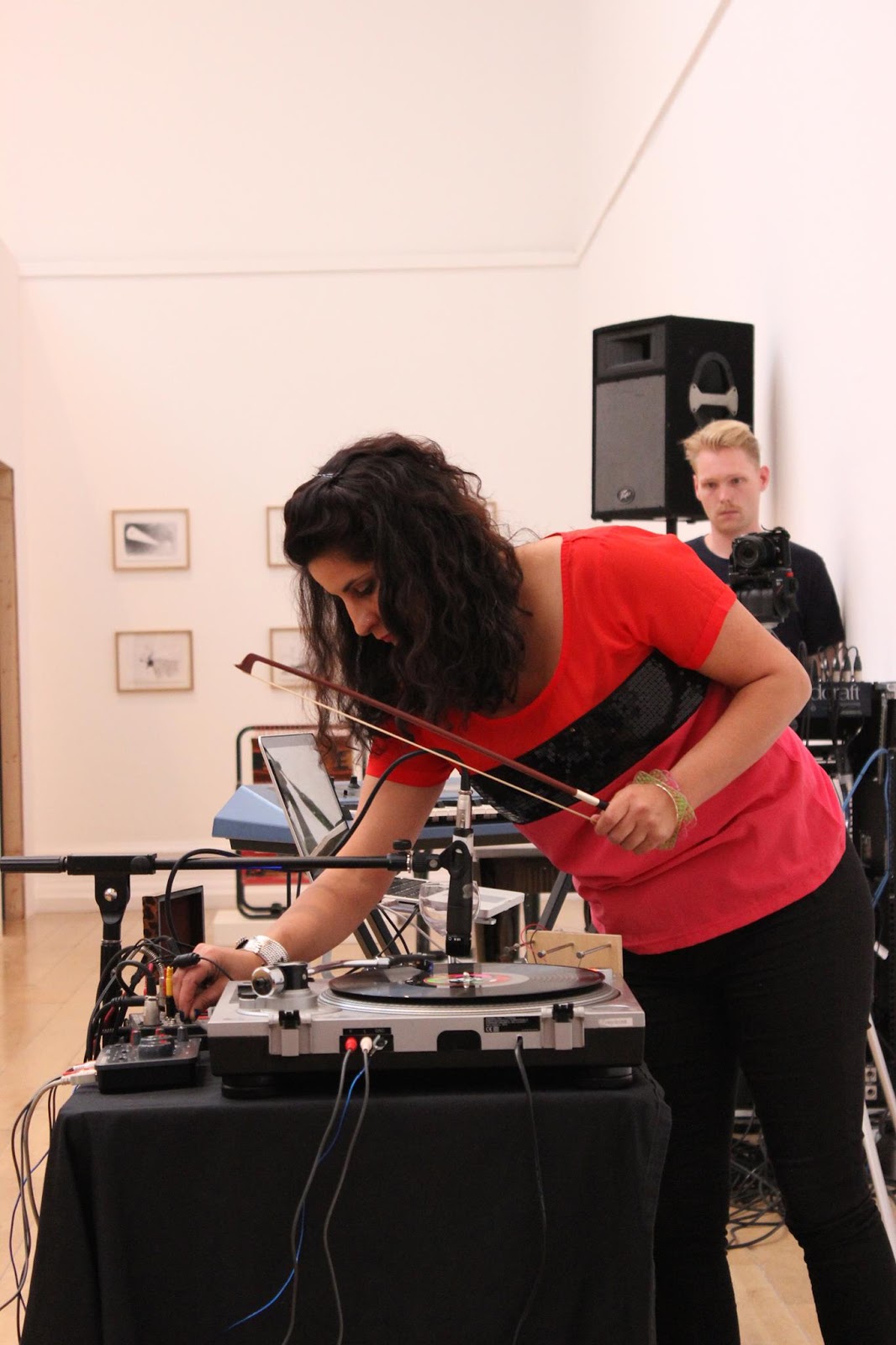
Fari B is a sound and installation artist, performer, and composer. Her work is intricate and exploratory; ambient and mesmerizing in a way that lingers throughout the day. She started playing piano as a child and later moved onto playing tenor saxophone in a jazz band. She has always been fascinated with the relationships involved in music-making and strives to balance work that involves experimentation and improv with her background playing as just one node in a larger ensemble. Fari has performed at and had work commissioned by the Institute of Contemporary Arts, the Middlesborough Museum of Modern Art, South London Gallery, Art Dubai, and Sound and Music UK, among many other museums and galleries.
“To be part of Always On feels like something is beginning.”
I’m Fari B, I was born in Iran in the 70s and came to England with my mum in the 80s. It was racist Britain under Thatcher, NF (National Front) all over the walls. Not a great time. But the Iranian revolution had happened and so we remained. Around this time a beautiful black French woman had noticed how drawn I was to her converted pianola, and gave it to me when she left the country, which transformed my life. I could sit for what seemed like hours in front of it and everything else just slipped away. It was an early form of meditation for me; I remember being aware of that quality the piano had. My mum worked hard to get me piano lessons and eventually I got a scholarship to a school where I could continue and begin the tenor sax too. It was mostly military stuff with the sax; I didn’t want to be in the jazz band. So it was all about marching in time, weaving in an out of one another in formations, and playing from little cards attached to the sax. It was as much about listening as playing, finding your pace in the whole 100 instruments. During the holidays, I’d routinely make detailed mix-tapes for friends using the radio, the built-in mic and our hugely eclectic record collection at home, which included spoken word and Indian music. Much time was spent listening to the radio and sewing, knitting even (again gifts), in the holidays. After studying classical music for a year in India, I studied journalism and learned how to edit audio.
Electronic music drew me for its power to edify and manipulate ordinary sounds as much as create out of this world ones. I began volunteering as an engineer at Resonance104.4FM, an arts-radio station in London. This was a major influence on me: the charity that was the London Musicians Collective, all the improvisers and the rule breakers(some very advanced in years); a whole community that truly inspired me. I composed with graphic scores for the Resonance Radio Orchestra, and performed other people’s works. We played in some cool places. All of it felt like a meditation, still.
To be part of Always On feels like something is beginning. I can’t see clearly yet, but I’m sure it will feel similar to being in that large band; listening and finding your place amongst the many voices.
Keep Up With Fari B
Mixcloud/Facebook
Sui Zhen
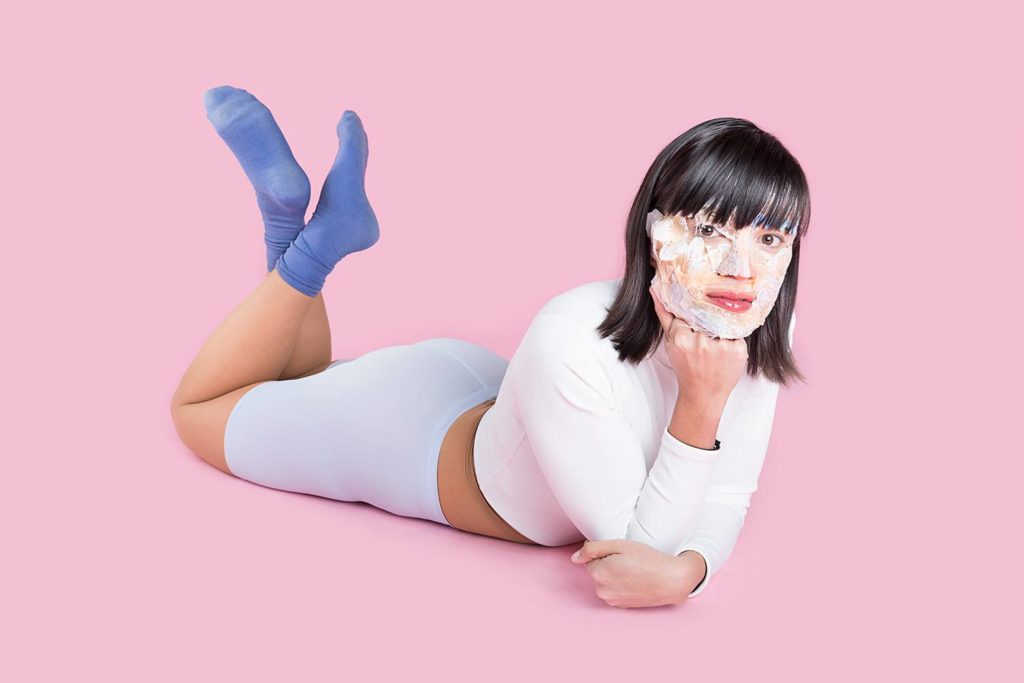
“Becky” Sui Zhen (also sometimes known as DJ Susan) makes work that’s light and poppy on the surface, but layered and elaborate upon closer examination. Sui Zhen isn’t just interested in making music, but exploring alter-egos and characters. In her musical endeavors and everyday life, she fluctuates between different names and identities to give her various selves — curated and otherwise — space to take risks and try on new ways of occupying space. Between her training in school concert band, grunge influences from her older brother and friends, and immersing herself in electronic dance scenes, her music has been informed by a number of different styles. It shows — amid her various personas and intrepid experimentation with sound, Sui Zhen has created a colorful body of work that examines identities and self-(re)presentation.
“I love the rhythm, repetition, simplicity and subtle changes that are possible with electronic music – it is music without words, music with the power to transcend reality. There’s a supernatural quality to this kind of music.”
Could you introduce yourself? Name, age, pronouns, where you’re from?
I introduce myself as Becky. I was born in 1985 and I grew up in the north western suburbs of Sydney in Australian bushland. For thousands of years, this special place filled with creeks, birds, lizards and subtropical storms was cared for by the Bidjigal people of the Dharug nation. Now I am based in the inner northern suburbs of Melbourne, tucked close to the Merri Creek on the land of the Wurundjeri-willam.
I have a lot of nicknames between family and friends, those names are like codes that tell me how the person knows me and from what era. Lately, I have been identifying as gender-neutral, queer or pan-sexual though I don’t feel the need to outwardly ascribe to any labels. Being raised female, I align closely with the issues faced by women of my generation. I am also Eurasian, with half of my heritage being Chinese Malaysian, the other is third-generation Australian-Scottish.
My late grandfather gave my generation of grandchildren (my siblings and cousins) each a ‘Sui’ name, the ‘Zhen’ in mine is the unique identifier. So when people address me for short as ‘Sui,’ it has the effect of calling someone by their family name. When it’s pronounced correctly, it has such a heartwarming effect. I love my Chinese name Sui Zhen and I first chose to use it for my musical project in 2006/7 so that I could always keep my heritage & culture within me. I remember being told to change my music name because it is “too hard to say;” people told me that for years when I first started out. I’m so glad I had the confidence then to not listen to them. Worse was when people assumed I made it up to be trendy. My grandpa gave me this name and it connects me to my brother, my sister, my mum, my grand-relatives, my aunties and uncles and cousins – it makes me feel special, in that way.
How did you get into music? How did that progress into electronic music?
I’ve been playing music as long as I can remember. My mum was a single parent, and she encouraged my siblings and I to take whatever extra curricular activities were offered to us. It probably helped to keep us curious and self-entertained given that she was juggling full-time work with three young children.
My first memories of singing start around the age of 8 or 9, I played a fat cat called Dongato and my two sung lyrics were “Meee-owwww, Meee-owww” followed by a subtle wave of my hand. From there I joined the vocal ensemble alongside my sister and we learned to sing harmonies and read music together; and we practiced a lot. I played trumpet in the school concert band, orchestra and jazz band right up until my mid-teens when I became too self conscious of how I looked when I played trumpet. so, I decided to audition for dramatic musical roles instead.
I picked up a guitar around age 14 or 15 and started writing songs that helped me express my feelings as well as obsessively recording mix tapes from the radio (the only source of new music back then). I had a long distance boyfriend from the South Coast of NSW. Their Fugazi inspired band, ‘Quirk’ recorded in Flea’s Congo studio and they eventually went on to tour with them, but on the cusp of their success they split ways. I saw how powerful music could be in connecting with people across societal and cultural divides, and I also saw how a certain kind of success could really divide people.
My elder brother showed me a lot of grunge and prog-rock and took me out to under-18 raves where the music was questionable but the vibe was strong. That was my first real introduction to electronic music – deep in the chaotic atmosphere of call-on-the-night raves coupled with experimenting with illicit substances during my final years of high school. I learned from my elder brother’s experience (who went from being almost being expelled for weed smoking to becoming School Captain) and balanced a high-achieving academic life amidst all that experimentation.
What is the appeal of electronic music for you?
I first connected with the sound of ambient, house and techno music. It was just at the cusp of the MySpace era; school friends were downloading Rage Against the Machine and Tool albums on Napster but that music alone didn’t satisfy me. The internet wasn’t yet where it is today, so finding new music came through new social connections. I started to hang out with DJs and people who collected vinyl. Their collections were diverse ranging from pastoral folk, reggae to Larry Heard. I would go to club nights like Sydney’s Madracket parties which always had a really inclusive culture and by my early twenties I realised I didn’t need any other substances; that good electronic music was enough get me high. I would show up sober at 1am at the club’s peak just to dance. I love the rhythm, repetition, simplicity and subtle changes that are possible with electronic music – it is music without words, music with the power to transcend reality. There’s a supernatural quality to this kind of music.
Who are some of the artists who have influenced your sound?
In my early twenties I discovered Arthur Russell. On the long bus rides to University, I would listen to his albums and marvel at his ability to blend folk and pop structures with disco and house production. I’d grown out of Bjork in my teens, but there was still a lot that her music did for me in the late 90s that I can still appreciate and to give her credit for showing me the scope of vast pop music. In terms of my sound today, I love the political impetus and the sound of bands grouped in the Krautrock genre, like Can, early Kraftwerk, Dunkelziffer. I long to bring this sound into what I am making next.
I’ve listened to a lot of City Pop from Japan 1980s, productions by Haruomi Hosono, YMO associated acts with female vocalists. I seek out a lot of minimal synth pop, anything that doesn’t get too hectic. When I started collecting records I ended up with a lot of Mad Professor produced music, Lover’s Rock and Sade spin-offs. I prefer female singers and producers if I can. A band called Antena (Isabelle Antena) are a big influence on my current sound; fusing bossanova with drum machines. Laurie Anderson, Mikado, Isabella Rossellini, Cindy Sherman, Sinead O’Connor (90s music), The Cranberries have all struck me in various ways.
How would you describe your sound to someone who’s never heard you before?
Lover’s rock inspired synth pop, Lounge/bossanova with drum machines, Dream beat. I usually tailor my description based on who I am talking to; Sade meets Kraftwerk inspired synth pop works for the average Uber driver.
For you, personally, what’s it like to be a part of Always On?
It’s a really exciting project and movement to be part of; a step toward breaking down the binary enforced upon us in the music industry. It is an opportunity to showcase diverse artists working within contemporary music today – and to give those people an uncontested platform of their own. Diversity within our music culture is so much more than filling quotas on lineups. It’s more than appearances – whilst appearances can provide clues, they don’t show you inside someone’s values or history to tell you who they are. Diversity is about engaging in an ongoing dialogue with our community, its history, and getting to know the voices that are often left outside the boundaries of definition to create a more inclusive space for all peoples. I’m honored to be involved.
Keep Up With Sui Zhen
Twitter/Facebook/Instagram
